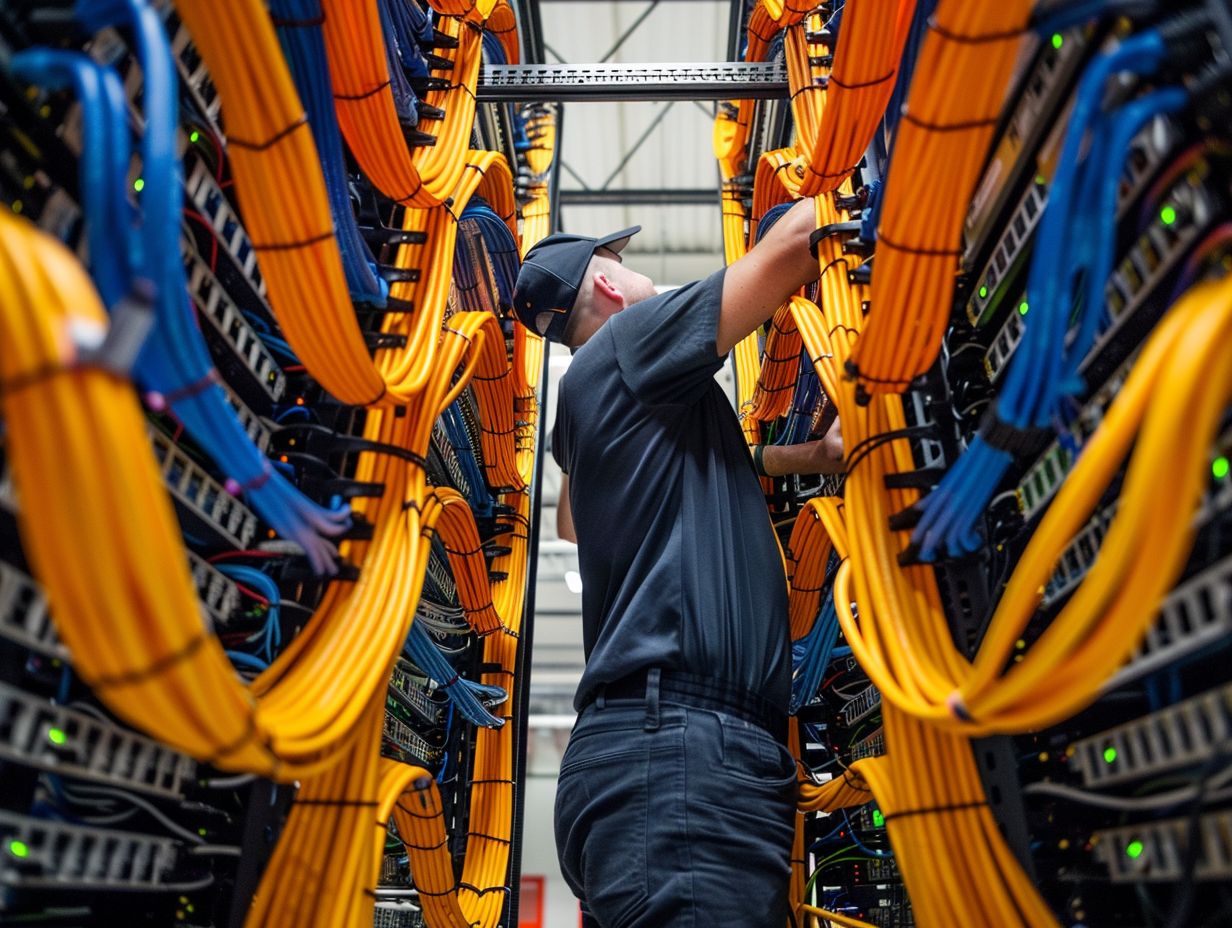Are you seeking to improve the performance and scalability of your data center networks while simultaneously minimizing complexity and costs?
The advantages of incorporating Fibre Channel and FCoE are examined, and a detailed guide on configuring them is provided. Additionally, we delve into recommended practices for achieving peak performance and reliability, as well as addressing prevalent challenges and employing troubleshooting methods.
Explore the forthcoming developments in data center networks involving Fibre Channel and FCoE, encompassing emerging technologies and trends.
Key Takeaways:

What are Fibre Channel and FCoE?
In data center environments, high-speed network technologies like Fibre Channel (FC) and Fibre Channel over Ethernet (FCoE) are commonly employed to facilitate efficient communication between storage devices and servers.
FC functions at the physical layer of the OSI model, utilizing specialized hardware such as HBAs and switches to ensure the transmission of data without loss and with minimal latency. Conversely, FCoE encapsulates Fibre Channel frames within Ethernet frames, allowing for the integration of storage and data networking into a unified Ethernet infrastructure.
This integration serves to simplify network management and reduce costs associated with maintaining separate networks for storage and data traffic within the data center. Both FC and FCoE offer high levels of performance, scalability, and reliability; however, the choice between the two depends on factors such as existing infrastructure, budgetary constraints, and specific deployment needs.
Benefits of Implementing Fibre Channel and FCoE
Utilizing Fibre Channel and FCoE technologies in your data center network presents notable benefits in terms of enhanced performance, streamlined complexity, and cost-effectiveness.
Improved Performance and Scalability
The implementation of Fibre Channel and FCoE can significantly enhance your network performance by providing high-speed data transfer, low latency, and improved scalability to accommodate growing traffic demands.
This improved performance is made possible through Fibre Channel’s ability to deliver data with minimal delays, ensuring that critical applications run smoothly and efficiently. FCoE, on the other hand, combines the benefits of Fibre Channel with Ethernet, allowing for faster data transmission over traditional Ethernet networks. By integrating Fibre Channel and FCoE into your infrastructure, you can experience reduced network congestion, faster response times, and seamless scalability as your data requirements increase.
Reduced Complexity and Cost
By adopting Fibre Channel and FCoE technologies, you can streamline your network infrastructure, decrease complexity, and reduce operational costs associated with managing storage devices and network configurations.
Integrating Fibre Channel and FCoE solutions allows organizations to centralize storage and networking resources, resulting in improved scalability and flexibility. These technologies facilitate seamless connections between servers and storage arrays within data centers, enhancing data access speeds and overall performance. Consolidating infrastructure through Fibre Channel and FCoE simplifies management tasks, optimizes resource allocation, and enhances security measures. The cost efficiencies offered by these solutions make them an appealing option for modern data center environments seeking to enhance operational efficiency and reliability.
Configuring Fibre Channel and FCoE in Data Center Networks

To establish Fibre Channel and FCoE in data center networks, you must follow a methodical configuration process that includes setting up VLANs, establishing fabric connectivity, and integrating devices. This meticulous approach is essential to guarantee smooth communication and achieve optimal performance.
Step-by-Step Guide
- A step-by-step guide for configuring Fibre Channel and FCoE in data center networks involves setting up interfaces, configuring traffic flow, and ensuring seamless communication between devices and the gateway fabric.
- To initiate the process, you should first configure the physical interfaces on the network devices to support Fibre Channel and FCoE. Assign appropriate IP addresses to the interfaces and verify that they are in the same subnet to facilitate smooth communication.
- Subsequently, establish the traffic flow by enabling the necessary protocols and adjusting Quality of Service (QoS) settings to prioritize Fibre Channel and FCoE traffic.
- Integrate the devices with the gateway fabric by configuring zoning to control access and ensure secure communication within the network.
- By meticulously following these steps, the Fibre Channel and FCoE configuration can be optimized for efficient data center operations.
Best Practices for Implementing Fibre Channel and FCoE
Following best practices is crucial when implementing Fibre Channel and FCoE solutions in data center networks to guarantee optimal performance, reliability, and scalability.
Tips for Optimal Performance and Reliability
To achieve optimal performance and reliability when using Fibre Channel and FCoE, you must adhere to industry best practices, accurately configure switches, and effectively implement command-line interface (CLI) commands.
Ensuring proper zoning and masking techniques on the switches is crucial for optimizing data flow and security in Fibre Channel environments. Regularly monitoring switch performance and traffic patterns using CLI commands can help you identify potential bottlenecks or issues and proactively address them before they escalate.
Utilizing troubleshooting techniques such as checking for errors in logs and running diagnostic tests can aid in swiftly resolving connectivity or compatibility issues that may arise. It is essential to stay updated on the latest firmware and software releases for switches to further enhance performance and stability.
Common Challenges and Troubleshooting Techniques
Mastering troubleshooting techniques and addressing common challenges are crucial skills for maintaining the stability and efficiency of Fibre Channel and FCoE networks, particularly in situations involving frame errors, MTU size discrepancies, and tagged-access issues.
Identifying and Resolving Issues

Efficiently identifying and resolving issues within Fibre Channel and FCoE networks requires a comprehensive understanding of VLAN configurations, gateway fabric topologies, and network interconnectivity.
When troubleshooting VLANs in a Fibre Channel environment, it is essential to check for misconfigurations such as overlapping VLAN IDs or mismatched trunking settings.
Optimizing fabric gateways requires ensuring consistent zoning and masking policies to prevent unauthorized access.
Resolving network connectivity issues may involve checking the physical layer for faulty cabling or SFP modules, verifying correct addressing schemes, and troubleshooting any switch port errors.
By following systematic troubleshooting steps and leveraging monitoring tools, network administrators can efficiently address common issues in Fibre Channel and FCoE deployments.
Future of Fibre Channel and FCoE in Data Center Networks
The future of Fibre Channel and FCoE in data center networks is on the verge of evolution, underpinned by emerging technologies, evolving network trends, and the growing need for enhanced performance and scalability.
Emerging Technologies and Trends
The evolution of Fibre Channel and FCoE in data center networks is currently incorporating emerging technologies like Software-Defined Storage (SDS), Converged Infrastructure, and advancements in SAN switches to address the growing requirements for flexibility, efficiency, and scalability.
These advancements are reshaping the data storage and networking environment, providing more agile and adaptable solutions for IT infrastructures. The integration of Software-Defined Storage (SDS) allows for effective management of data across different storage resources, leading to improved resource utilization and reduced operational costs.
Converged Infrastructure models bring together compute, storage, and networking elements into a consolidated platform, simplifying deployment and management procedures. The latest progress in SAN switches offers higher speeds, lower latency, and enhanced reliability, meeting the increasing data demands of modern enterprises.
Frequently Asked Questions
What is Fibre Channel and how is it used in Data Center Networks?
Fibre Channel is a high-speed data transfer technology that is commonly used in data center networks for storage area networks (SANs). It allows for the transfer of large amounts of data between servers and storage devices at extremely fast speeds, making it ideal for data-intensive applications and workloads.
What is FCoE and how does it differ from Fibre Channel?

FCoE, or Fibre Channel over Ethernet, is a newer technology that allows for Fibre Channel traffic to be sent over standard Ethernet networks. This eliminates the need for separate Fibre Channel networks in the data center, reducing costs and simplifying network management. FCoE offers the same high-speed, low-latency performance as traditional Fibre Channel.
How do I configure Fibre Channel and FCoE in my data center network?
The exact steps for configuring Fibre Channel and FCoE will vary depending on the specific devices and network setup. In general, you will need to ensure that your switch and server hardware supports these technologies, and then configure the necessary ports and settings on your devices. It is recommended to consult with the manufacturer’s documentation or seek assistance from a professional for proper configuration.
Can Fibre Channel and FCoE coexist in the same data center network?
Yes, Fibre Channel and FCoE can coexist in the same network. In fact, many organizations use a combination of both technologies to meet different storage and data transfer needs. However, proper configuration and management are crucial to ensure smooth coexistence and optimal performance.
What are the benefits of using Fibre Channel and FCoE in data center networks?
Some of the main benefits of using Fibre Channel and FCoE in data center networks include high-speed data transfer, low latency, and the ability to support large amounts of data. Additionally, these technologies can help reduce costs and simplify network management by consolidating storage and data traffic onto a single network.
Are there any security concerns with using Fibre Channel and FCoE in data center networks?
Security should always be a top priority when configuring any type of network. With Fibre Channel and FCoE, it is important to properly configure access controls and authentication measures to prevent unauthorized access to sensitive data. Regular monitoring and updates to security protocols are also recommended to ensure the integrity and safety of your data.
